dashboard Alfa Romeo 156 2004 Owner handbook (in English)
[x] Cancel search | Manufacturer: ALFA ROMEO, Model Year: 2004, Model line: 156, Model: Alfa Romeo 156 2004Pages: 357, PDF Size: 5.04 MB
Page 12 of 357
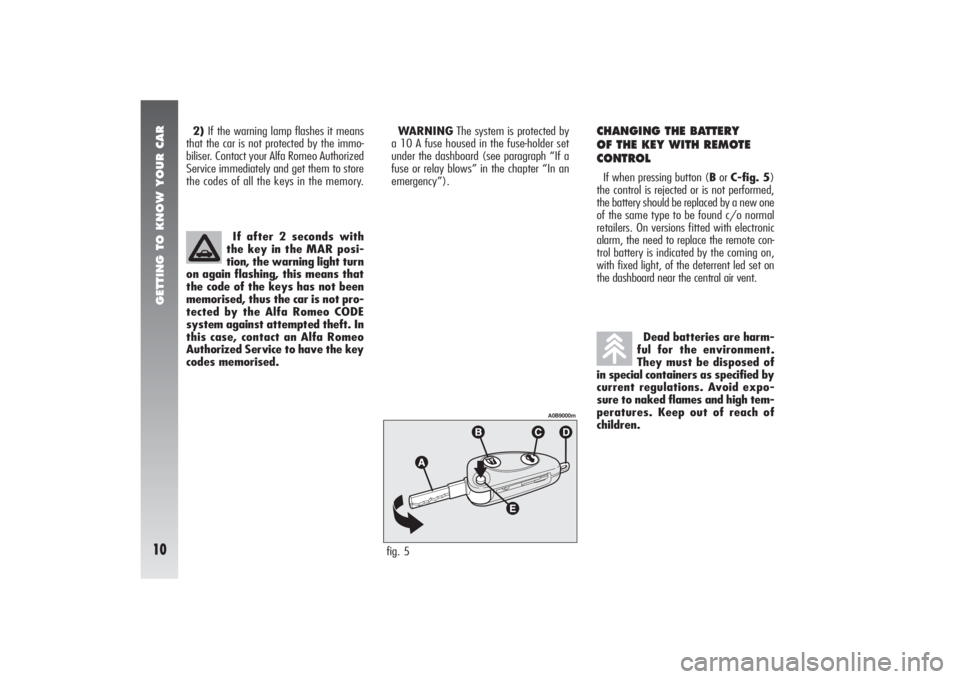
GETTING TO KNOW YOUR CAR10
2)If the warning lamp flashes it means
that the car is not protected by the immo-
biliser. Contact your Alfa Romeo Authorized
Service immediately and get them to store
the codes of all the keys in the memory.
CHANGING THE BATTERY
OF THE KEY WITH REMOTE
CONTROLIf when pressing button (Bor C-fig. 5)
the control is rejected or is not performed,
the battery should be replaced by a new one
of the same type to be found c/o normal
retailers. On versions fitted with electronic
alarm, the need to replace the remote con-
trol battery is indicated by the coming on,
with fixed light, of the deterrent led set on
the dashboard near the central air vent. If after 2 seconds with
the key in the MAR posi-
tion, the warning light turn
on again flashing, this means that
the code of the keys has not been
memorised, thus the car is not pro-
tected by the Alfa Romeo CODE
system against attempted theft. In
this case, contact an Alfa Romeo
Authorized Service to have the key
codes memorised.
Dead batteries are harm-
ful for the environment.
They must be disposed of
in special containers as specified by
current regulations. Avoid expo-
sure to naked flames and high tem-
peratures. Keep out of reach of
children.
fig. 5
A0B9000m
WARNINGThe system is protected by
a 10 A fuse housed in the fuse-holder set
under the dashboard (see paragraph “If a
fuse or relay blows” in the chapter “In an
emergency”).
Page 14 of 357
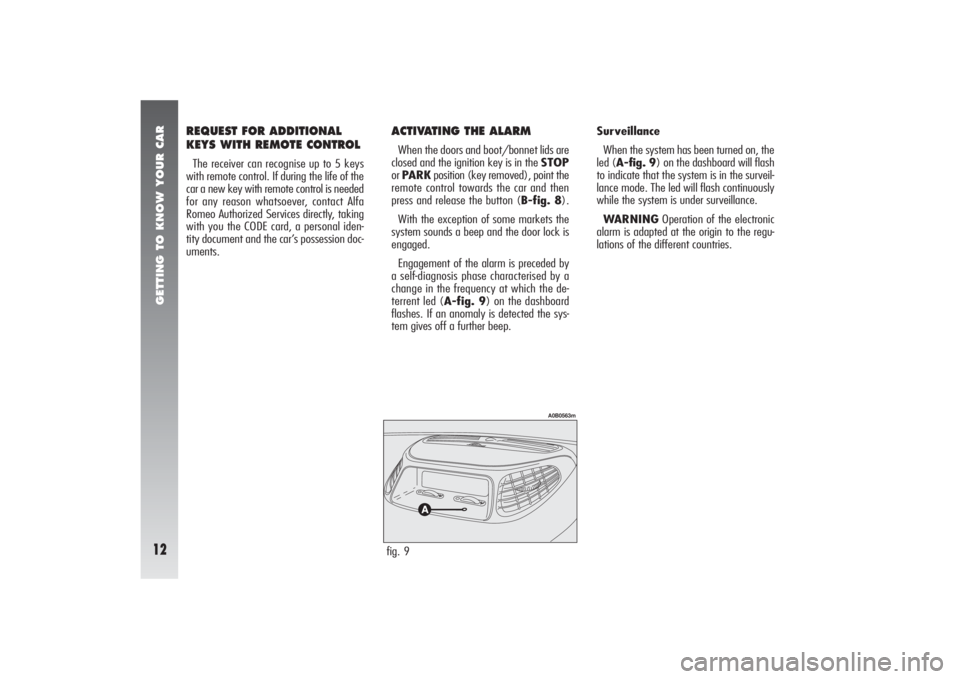
GETTING TO KNOW YOUR CAR12
REQUEST FOR ADDITIONAL
KEYS WITH REMOTE CONTROLThe receiver can recognise up to 5 keys
with remote control. If during the life of the
car a new key with remote control is needed
for any reason whatsoever, contact Alfa
Romeo Authorized Services directly, taking
with you the CODE card, a personal iden-
tity document and the car’s possession doc-
uments.
ACTIVATING THE ALARMWhen the doors and boot/bonnet lids are
closed and the ignition key is in the STOP
or PARKposition (key removed), point the
remote control towards the car and then
press and release the button (B-fig. 8).
With the exception of some markets the
system sounds a beep and the door lock is
engaged.
Engagement of the alarm is preceded by
a self-diagnosis phase characterised by a
change in the frequency at which the de-
terrent led (A-fig. 9) on the dashboard
flashes. If an anomaly is detected the sys-
tem gives off a further beep.fig. 9
A0B0563m
Surveillance
When the system has been turned on, the
led (A-fig. 9) on the dashboard will flash
to indicate that the system is in the surveil-
lance mode. The led will flash continuously
while the system is under surveillance.
WARNINGOperation of the electronic
alarm is adapted at the origin to the regu-
lations of the different countries.
Page 37 of 357
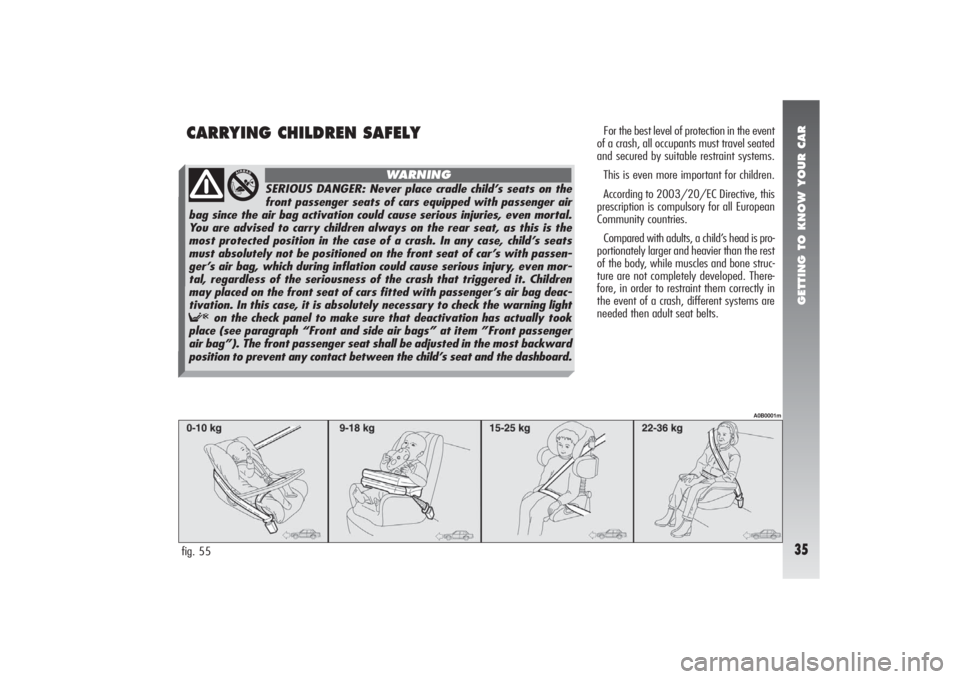
GETTING TO KNOW YOUR CAR35
CARRYING CHILDREN SAFELYfig. 55
A0B0001m
For the best level of protection in the event
of a crash, all occupants must travel seated
and secured by suitable restraint systems.
This is even more important for children.
According to 2003/20/EC Directive, this
prescription is compulsory for all European
Community countries.
Compared with adults, a child’s head is pro-
portionately larger and heavier than the rest
of the body, while muscles and bone struc-
ture are not completely developed. There-
fore, in order to restraint them correctly in
the event of a crash, different systems are
needed then adult seat belts.
SERIOUS DANGER: Never place cradle child’s seats on the
front passenger seats of cars equipped with passenger air
bag since the air bag activation could cause serious injuries, even mortal.
You are advised to carry children always on the rear seat, as this is the
most protected position in the case of a crash. In any case, child’s seats
must absolutely not be positioned on the front seat of car’s with passen-
ger’s air bag, which during inflation could cause serious injury, even mor-
tal, regardless of the seriousness of the crash that triggered it. Children
may placed on the front seat of cars fitted with passenger’s air bag deac-
tivation. In this case, it is absolutely necessary to check the warning light
Fon the check panel to make sure that deactivation has actually took
place (see paragraph “Front and side air bags” at item ”Front passenger
air bag”). The front passenger seat shall be adjusted in the most backward
position to prevent any contact between the child’s seat and the dashboard.
WARNING
Page 44 of 357
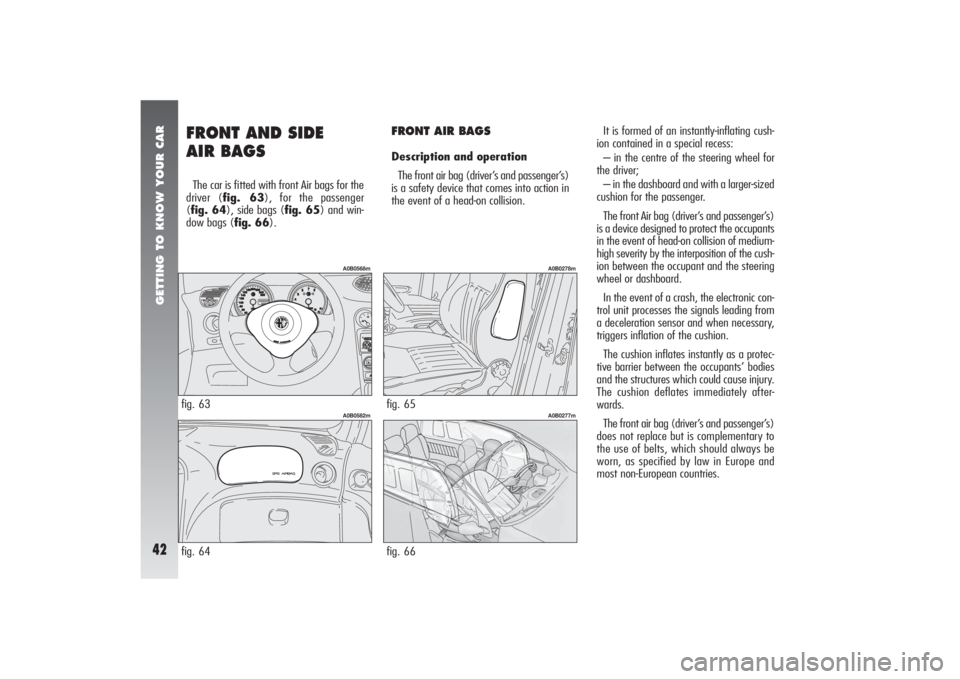
GETTING TO KNOW YOUR CAR42
FRONT AND SIDE
AIR BAGS The car is fitted with front Air bags for the
driver (fig. 63), for the passenger
(fig. 64), side bags (fig. 65) and win-
dow bags (fig. 66).
FRONT AIR BAGSDescription and operation
The front air bag (driver’s and passenger’s)
is a safety device that comes into action in
the event of a head-on collision.It is formed of an instantly-inflating cush-
ion contained in a special recess:
– in the centre of the steering wheel for
the driver;
– in the dashboard and with a larger-sized
cushion for the passenger.
The front Air bag (driver’s and passenger’s)
is a device designed to protect the occupants
in the event of head-on collision of medium-
high severity by the interposition of the cush-
ion between the occupant and the steering
wheel or dashboard.
In the event of a crash, the electronic con-
trol unit processes the signals leading from
a deceleration sensor and when necessary,
triggers inflation of the cushion.
The cushion inflates instantly as a protec-
tive barrier between the occupants’ bodies
and the structures which could cause injury.
The cushion deflates immediately after-
wards.
The front air bag (driver’s and passenger’s)
does not replace but is complementary to
the use of belts, which should always be
worn, as specified by law in Europe and
most non-European countries.
fig. 63
A0B0568m
fig. 64
A0B0582m
fig. 65
A0B0278m
fig. 66
A0B0277m
Page 45 of 357
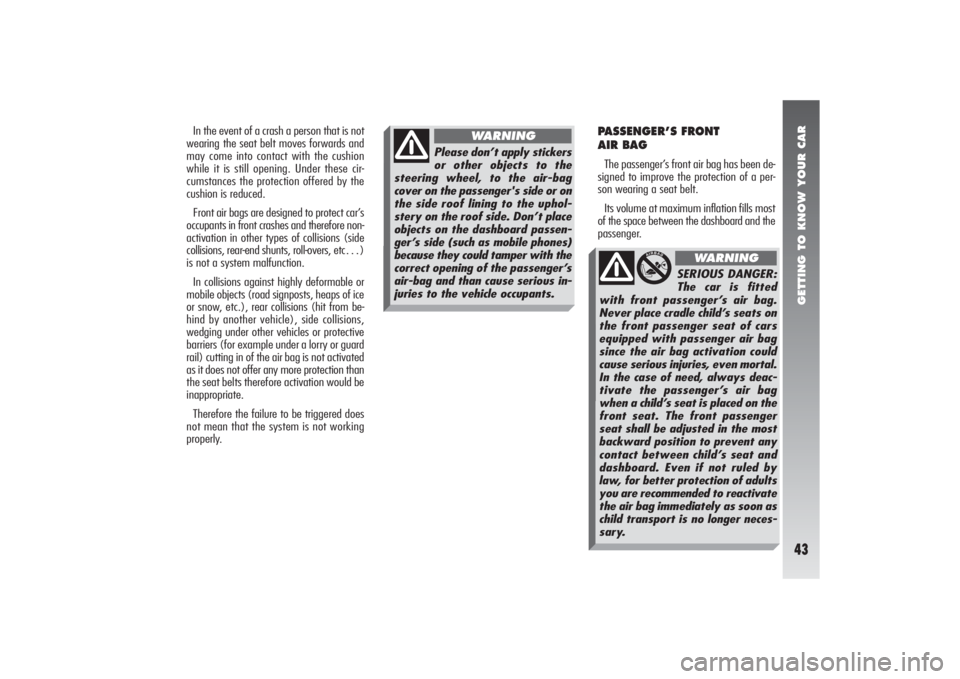
GETTING TO KNOW YOUR CAR43
In the event of a crash a person that is not
wearing the seat belt moves forwards and
may come into contact with the cushion
while it is still opening. Under these cir-
cumstances the protection offered by the
cushion is reduced.
Front air bags are designed to protect car’s
occupants in front crashes and therefore non-
activation in other types of collisions (side
collisions, rear-end shunts, roll-overs, etc…)
is not a system malfunction.
In collisions against highly deformable or
mobile objects (road signposts, heaps of ice
or snow, etc.), rear collisions (hit from be-
hind by another vehicle), side collisions,
wedging under other vehicles or protective
barriers (for example under a lorry or guard
rail) cutting in of the air bag is not activated
as it does not offer any more protection than
the seat belts therefore activation would be
inappropriate.
Therefore the failure to be triggered does
not mean that the system is not working
properly.
PASSENGER’S FRONT
AIR BAGThe passenger’s front air bag has been de-
signed to improve the protection of a per-
son wearing a seat belt.
Its volume at maximum inflation fills most
of the space between the dashboard and the
passenger.
SERIOUS DANGER:
The car is fitted
with front passenger’s air bag.
Never place cradle child’s seats on
the front passenger seat of cars
equipped with passenger air bag
since the air bag activation could
cause serious injuries, even mortal.
In the case of need, always deac-
tivate the passenger’s air bag
when a child’s seat is placed on the
front seat. The front passenger
seat shall be adjusted in the most
backward position to prevent any
contact between child’s seat and
dashboard. Even if not ruled by
law, for better protection of adults
you are recommended to reactivate
the air bag immediately as soon as
child transport is no longer neces-
sary.
WARNING
Please don’t apply stickers
or other objects to the
steering wheel, to the air-bag
cover on the passenger's side or on
the side roof lining to the uphol-
stery on the roof side. Don’t place
objects on the dashboard passen-
ger’s side (such as mobile phones)
because they could tamper with the
correct opening of the passenger’s
air-bag and than cause serious in-
juries to the vehicle occupants.
WARNING
Page 46 of 357
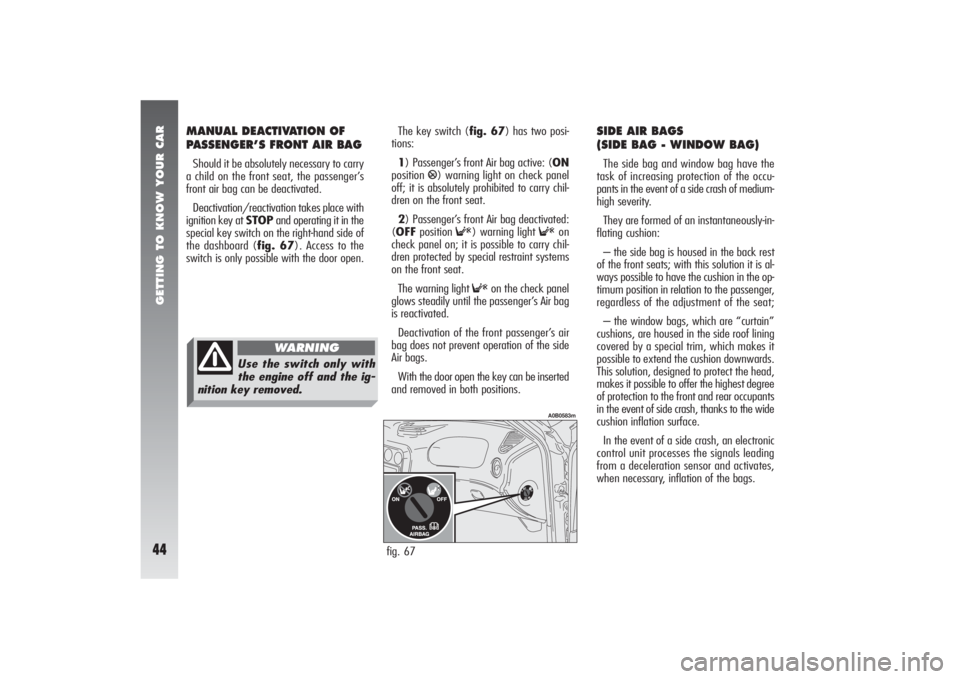
GETTING TO KNOW YOUR CAR44
MANUAL DEACTIVATION OF
PASSENGER’S FRONT AIR BAGShould it be absolutely necessary to carry
a child on the front seat, the passenger’s
front air bag can be deactivated.
Deactivation/reactivation takes place with
ignition key at STOPand operating it in the
special key switch on the right-hand side of
the dashboard (fig. 67). Access to the
switch is only possible with the door open.The key switch (fig. 67) has two posi-
tions:
1) Passenger’s front Air bag active: (ON
position
P) warning light on check panel
off; it is absolutely prohibited to carry chil-
dren on the front seat.
2) Passenger’s front Air bag deactivated:
(OFFposition
F
) warning light
F
on
check panel on; it is possible to carry chil-
dren protected by special restraint systems
on the front seat.
The warning light
F
on the check panel
glows steadily until the passenger’s Air bag
is reactivated.
Deactivation of the front passenger’s air
bag does not prevent operation of the side
Air bags.
With the door open the key can be inserted
and removed in both positions.
SIDE AIR BAGS
(SIDE BAG - WINDOW BAG)The side bag and window bag have the
task of increasing protection of the occu-
pants in the event of a side crash of medium-
high severity.
They are formed of an instantaneously-in-
flating cushion:
– the side bag is housed in the back rest
of the front seats; with this solution it is al-
ways possible to have the cushion in the op-
timum position in relation to the passenger,
regardless of the adjustment of the seat;
– the window bags, which are “curtain”
cushions, are housed in the side roof lining
covered by a special trim, which makes it
possible to extend the cushion downwards.
This solution, designed to protect the head,
makes it possible to offer the highest degree
of protection to the front and rear occupants
in the event of side crash, thanks to the wide
cushion inflation surface.
In the event of a side crash, an electronic
control unit processes the signals leading
from a deceleration sensor and activates,
when necessary, inflation of the bags.
fig. 67
A0B0583m
Use the switch only with
the engine off and the ig-
nition key removed.
WARNING
Page 48 of 357
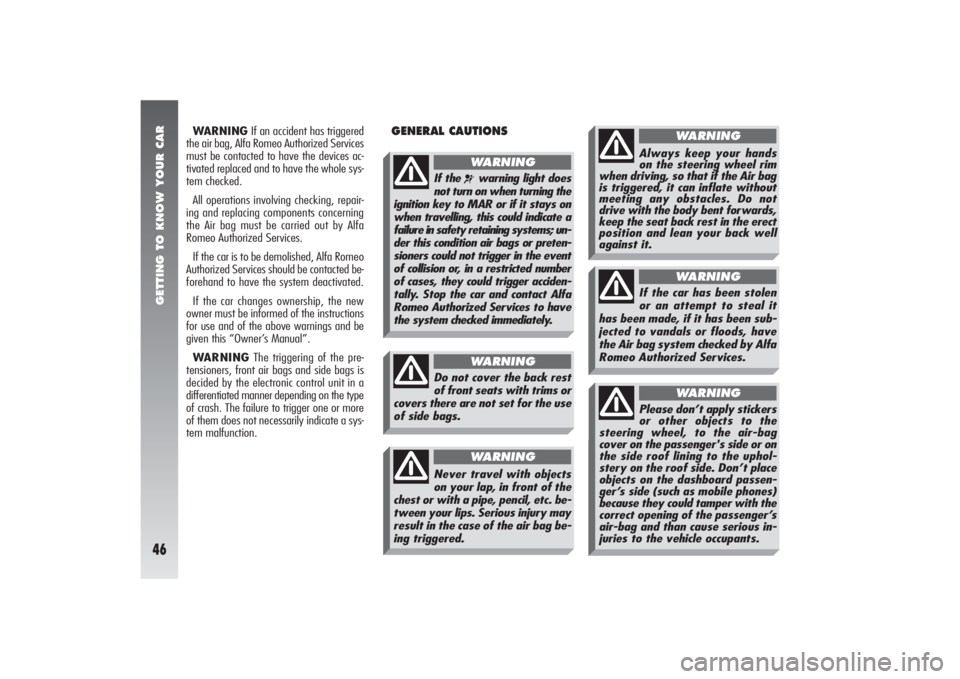
GETTING TO KNOW YOUR CAR46
WARNINGIf an accident has triggered
the air bag, Alfa Romeo Authorized Services
must be contacted to have the devices ac-
tivated replaced and to have the whole sys-
tem checked.
All operations involving checking, repair-
ing and replacing components concerning
the Air bag must be carried out by Alfa
Romeo Authorized Services.
If the car is to be demolished, Alfa Romeo
Authorized Services should be contacted be-
forehand to have the system deactivated.
If the car changes ownership, the new
owner must be informed of the instructions
for use and of the above warnings and be
given this “Owner’s Manual”.
WARNINGThe triggering of the pre-
tensioners, front air bags and side bags is
decided by the electronic control unit in a
differentiated manner depending on the type
of crash. The failure to trigger one or more
of them does not necessarily indicate a sys-
tem malfunction.
GENERAL CAUTIONS
If the
¬
warning light does
not turn on when turning the
ignition key to MAR or if it stays on
when travelling, this could indicate a
failure in safety retaining systems; un-
der this condition air bags or preten-
sioners could not trigger in the event
of collision or, in a restricted number
of cases, they could trigger acciden-
tally. Stop the car and contact Alfa
Romeo Authorized Services to have
the system checked immediately.WARNING
Do not cover the back rest
of front seats with trims or
covers there are not set for the use
of side bags.
WARNING
Never travel with objects
on your lap, in front of the
chest or with a pipe, pencil, etc. be-
tween your lips. Serious injury may
result in the case of the air bag be-
ing triggered.
WARNING
Always keep your hands
on the steering wheel rim
when driving, so that if the Air bag
is triggered, it can inflate without
meeting any obstacles. Do not
drive with the body bent forwards,
keep the seat back rest in the erect
position and lean your back well
against it.
WARNING
If the car has been stolen
or an attempt to steal it
has been made, if it has been sub-
jected to vandals or floods, have
the Air bag system checked by Alfa
Romeo Authorized Services.
WARNING
Please don’t apply stickers
or other objects to the
steering wheel, to the air-bag
cover on the passenger's side or on
the side roof lining to the uphol-
stery on the roof side. Don’t place
objects on the dashboard passen-
ger’s side (such as mobile phones)
because they could tamper with the
correct opening of the passenger’s
air-bag and than cause serious in-
juries to the vehicle occupants.
WARNING
Page 50 of 357
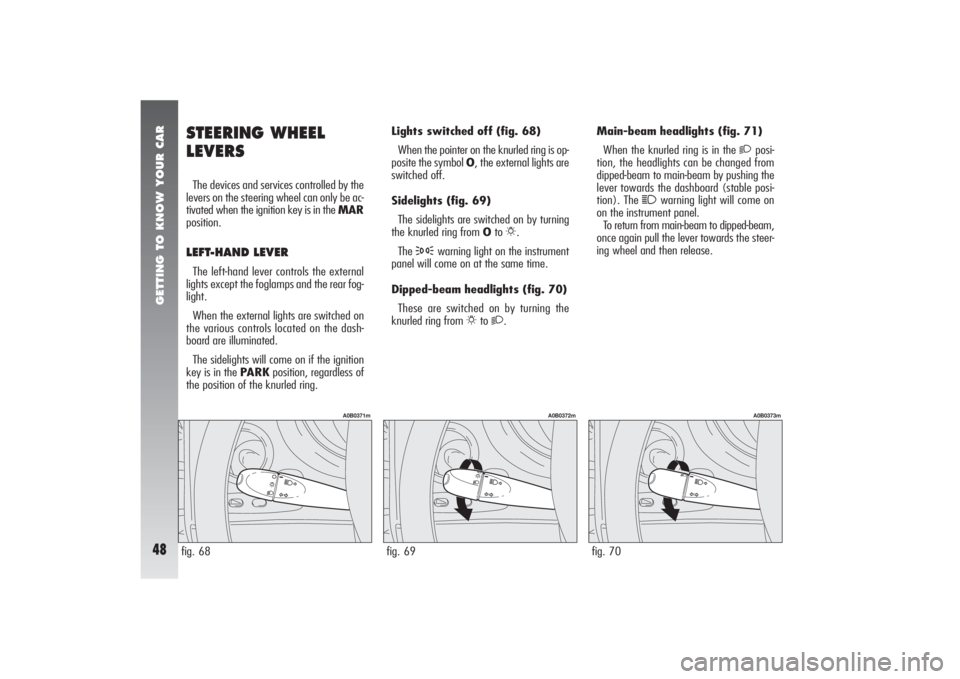
GETTING TO KNOW YOUR CAR48
fig. 70
A0B0373m
STEERING WHEEL
LEVERSThe devices and services controlled by the
levers on the steering wheel can only be ac-
tivated when the ignition key is in the MAR
position.LEFT-HAND LEVERThe left-hand lever controls the external
lights except the foglamps and the rear fog-
light.
When the external lights are switched on
the various controls located on the dash-
board are illuminated.
The sidelights will come on if the ignition
key is in the PARKposition, regardless of
the position of the knurled ring.Lights switched off (fig. 68)
When the pointer on the knurled ring is op-
posite the symbol O, the external lights are
switched off.
Sidelights (fig. 69)
The sidelights are switched on by turning
the knurled ring from Oto
6.
The
3
warning light on the instrument
panel will come on at the same time.
Dipped-beam headlights (fig. 70)
These are switched on by turning the
knurled ring from
6
to 2
.Main-beam headlights (fig. 71)
When the knurled ring is in the
2
posi-
tion, the headlights can be changed from
dipped-beam to main-beam by pushing the
lever towards the dashboard (stable posi-
tion). The
1
warning light will come on
on the instrument panel.
To return from main-beam to dipped-beam,
once again pull the lever towards the steer-
ing wheel and then release.
fig. 68
A0B0371m
fig. 69
A0B0372m
Page 58 of 357
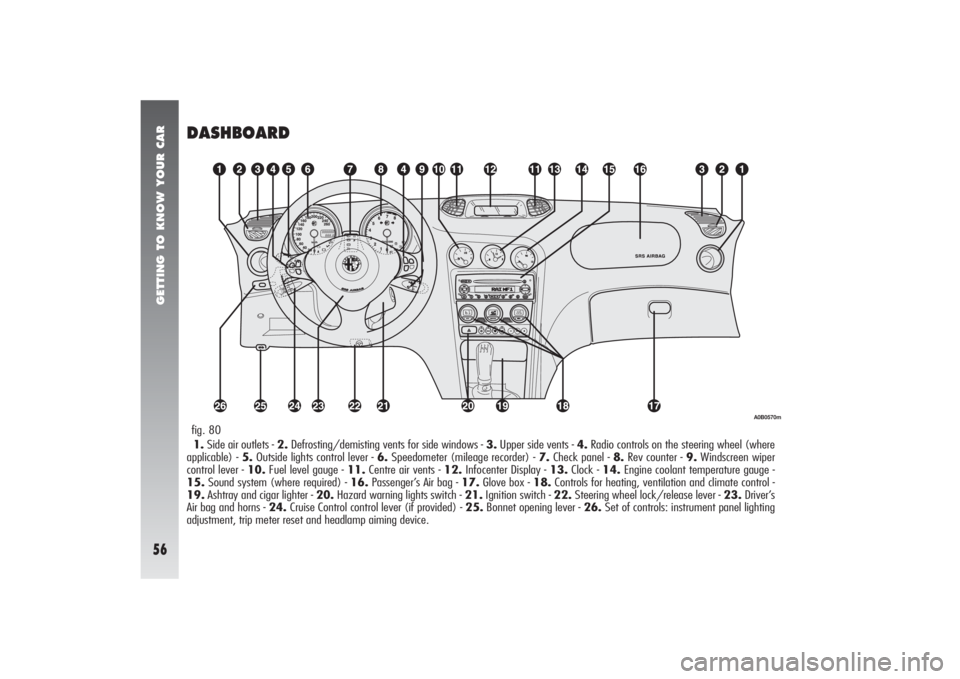
GETTING TO KNOW YOUR CAR56
DASHBOARD1.Side air outlets - 2.Defrosting/demisting vents for side windows - 3.Upper side vents - 4.Radio controls on the steering wheel (where
applicable) - 5.Outside lights control lever - 6.Speedometer (mileage recorder) - 7.Check panel - 8.Rev counter - 9.Windscreen wiper
control lever - 10.Fuel level gauge - 11.Centre air vents - 12.Infocenter Display - 13.Clock - 14.Engine coolant temperature gauge -
15.Sound system (where required) - 16.Passenger’s Air bag - 17.Glove box - 18.Controls for heating, ventilation and climate control -
19.Ashtray and cigar lighter - 20.Hazard warning lights switch - 21.Ignition switch - 22.Steering wheel lock/release lever - 23.Driver’s
Air bag and horns - 24.Cruise Control control lever (if provided) - 25.Bonnet opening lever - 26.Set of controls: instrument panel lighting
adjustment, trip meter reset and headlamp aiming device.fig. 80
A0B0570m
Page 111 of 357

GETTING TO KNOW YOUR CAR
109
UPPER VENT ADJUSTMENT(fig. 95)
The vent has an opening/closing control.•
= Completely closed.
)= Completely open.
CENTRE VENT ADJUSTMENT(fig. 96)
Each vent has a lever which makes it pos-
sible to direct the flow of air towards the
passengers in an horizontal direction. To ad-
just the air flow, use the opening/closing
centre vent device.•
= Completely closed.
(= Completely open.
UPPER SIDE VENT ADJUSTMENT(fig. 97)
On the dashboard ends are adjustable vents
(A) for car interior, and fixed defrosting/
demisting vents (B) for side windows.
Air flow can be adjusted by means of the
knob (C).•
= Completely closed.
)= Completely open.
fig. 95
A0B0572m
fig. 96
A0B0573m
fig. 97
A0B0039m